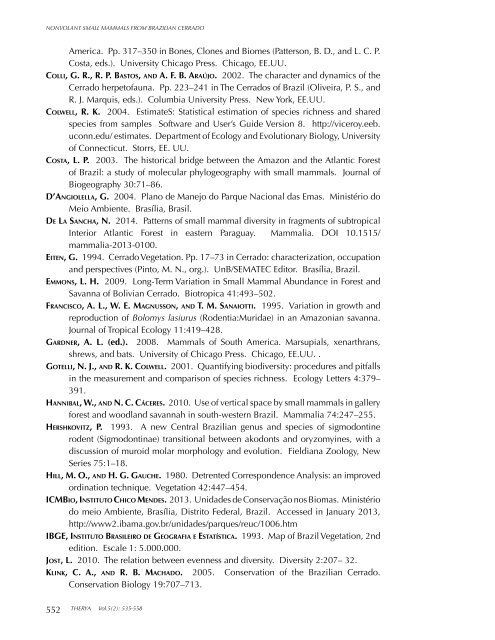therya-5_2
therya-5_2
therya-5_2
You also want an ePaper? Increase the reach of your titles
YUMPU automatically turns print PDFs into web optimized ePapers that Google loves.
NONVOLANT SMALL MAMMALS FROM BRAZILIAN CERRADO<br />
America. Pp. 317–350 in Bones, Clones and Biomes (Patterson, B. D., and L. C. P.<br />
Costa, eds.). University Chicago Press. Chicago, EE.UU.<br />
Colli, G. R., R. P. Bastos, and A. F. B. Araújo. 2002. The character and dynamics of the<br />
Cerrado herpetofauna. Pp. 223–241 in The Cerrados of Brazil (Oliveira, P. S., and<br />
R. J. Marquis, eds.). Columbia University Press. New York, EE.UU.<br />
Colwell, R. K. 2004. EstimateS: Statistical estimation of species richness and shared<br />
species from samples Software and User’s Guide Version 8. http://viceroy.eeb.<br />
uconn.edu/ estimates. Department of Ecology and Evolutionary Biology, University<br />
of Connecticut. Storrs, EE. UU.<br />
Costa, L. P. 2003. The historical bridge between the Amazon and the Atlantic Forest<br />
of Brazil: a study of molecular phylogeography with small mammals. Journal of<br />
Biogeography 30:71–86.<br />
D’Angiolella, G. 2004. Plano de Manejo do Parque Nacional das Emas. Ministério do<br />
Meio Ambiente. Brasília, Brasil.<br />
De La Sancha, N. 2014. Patterns of small mammal diversity in fragments of subtropical<br />
Interior Atlantic Forest in eastern Paraguay. Mammalia. DOI 10.1515/<br />
mammalia-2013-0100.<br />
Eiten, G. 1994. Cerrado Vegetation. Pp. 17–73 in Cerrado: characterization, occupation<br />
and perspectives (Pinto, M. N., org.). UnB/SEMATEC Editor. Brasília, Brazil.<br />
Emmons, L. H. 2009. Long-Term Variation in Small Mammal Abundance in Forest and<br />
Savanna of Bolivian Cerrado. Biotropica 41:493–502.<br />
Francisco, A. L., W. E. Magnusson, and T. M. Sanaiotti. 1995. Variation in growth and<br />
reproduction of Bolomys lasiurus (Rodentia:Muridae) in an Amazonian savanna.<br />
Journal of Tropical Ecology 11:419–428.<br />
Gardner, A. L. (ed.). 2008. Mammals of South America. Marsupials, xenarthrans,<br />
shrews, and bats. University of Chicago Press. Chicago, EE.UU. .<br />
Gotelli, N. J., and R. K. Colwell. 2001. Quantifying biodiversity: procedures and pitfalls<br />
in the measurement and comparison of species richness. Ecology Letters 4:379–<br />
391.<br />
Hannibal, W., and N. C. Cáceres. 2010. Use of vertical space by small mammals in gallery<br />
forest and woodland savannah in south-western Brazil. Mammalia 74:247–255.<br />
Hershkovitz, P. 1993. A new Central Brazilian genus and species of sigmodontine<br />
rodent (Sigmodontinae) transitional between akodonts and oryzomyines, with a<br />
discussion of muroid molar morphology and evolution. Fieldiana Zoology, New<br />
Series 75:1–18.<br />
Hill, M. O., and H. G. Gauche. 1980. Detrented Correspondence Analysis: an improved<br />
ordination technique. Vegetation 42:447–454.<br />
ICMBio, Instituto Chico Mendes. 2013. Unidades de Conservação nos Biomas. Ministério<br />
do meio Ambiente, Brasília, Distrito Federal, Brazil. Accessed in January 2013,<br />
http://www2.ibama.gov.br/unidades/parques/reuc/1006.htm<br />
IBGE, Instituto Brasileiro de Geografia e Estatística. 1993. Map of Brazil Vegetation, 2nd<br />
edition. Escale 1: 5.000.000.<br />
Jost, L. 2010. The relation between evenness and diversity. Diversity 2:207– 32.<br />
Klink, C. A., and R. B. Machado. 2005. Conservation of the Brazilian Cerrado.<br />
Conservation Biology 19:707–713.<br />
552<br />
THERYA Vol.5(2): 535-558



